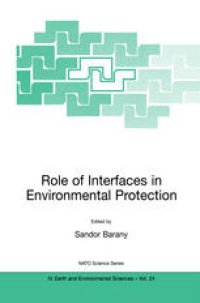
Ebook: Role of Interfaces in Environmental Protection
- Tags: Physical Chemistry, Waste Water Technology / Water Pollution Control / Water Management / Aquatic Pollution, Environmental Engineering/Biotechnology
- Series: NATO Science Series 24
- Year: 2003
- Publisher: Springer Netherlands
- Edition: 1
- Language: English
- pdf
The NATO Advanced Research Workshop "Role of Interfaces in Environmental Protection" has been held on May 27-30, 2002 in Miskolc, Hungary, under leadership of co-directors Prof Sandor Barany from the University ofMiskolc, Hungary, and Prof Nataliya Klymenko, National Academy of Sciences of Ukraine. The objective of the ARW was to highlight colloidal and biocolloidal aspects of environmental pollution and technologies to monitor, remediate, abate and prevent pollution. It is known that the solution of majority of environmental problems is closely connected with phenomena at the interfaces. The behaviour, transport of dispersed particles in the environment, the main phase separation methods in water treatment, purification of liquids, aerosols removal, many soil remediation processes as well as the methods of protection of human organisms from hazardous matters, are based on concepts of colloid chemistry, i.e. properties of interfaces and their behaviour in different media. Examples of these methods are: filtration, ultrafiltration, flotation, coagulation, hetero-coagulation and flocculation, adsorption, adhesion of micro-organisms to surfaces, membrane separation methods, etc. A very important and special aspect of the topic is the human protection using colloid-chemical approaches, i.e. the adsorption, aggregation and adagulation properties of differe~t materials. Examples are: adsorption of hazardous organic materials, drugs, heavy· metals and radionuclides on activated carbon, silica, cellulose derivatives, etc.
The book highlights the colloidal and biocolloidal aspects of environmental pollution and technologies to monitor, remediate, abate and prevent pollution.
The solution to the majority of environmental problems is closely connected with interfacial phenomena. The behaviour and transport of dispersed particles in the environment, the main phase separation methods in water treatment, liquid treatment, aerosol removal and many soil remediation processes, as well as methods for protecting humans from hazardous matter, are based on concepts of colloid chemistry, i.e. the properties of interfaces and their behaviour in different media.
The book discusses a wide range of ecological problems, namely: colloidal stability and behavior of colloids - including radionuclides - in the environment, methods for monitoring the environment, use of adsorption, bioadsorption, coagulation, polymeric materials and membranes in water treatment, some modern methods of soil remediation, and the protection of humans using colloid-chemical processes.